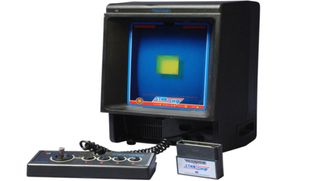Don't cry

We've given you a complete history of failed consoles, lovingly suffocating you with info on almost 60 mediocre machines in the process. And while well all be better off never mentioning the Casio Loopy or Action Max again, we just had the nagging feeling that some of the consoles on that list deserved more. You see, every once in awhile a console comes along that fails for reasons largely out of its control. Maybe its too ahead of its time; maybe it has one little design flaw that throws the whole thing out of whack; or maybe its distributed by an incompetent company.
Either way, the annals of gaming history are home to a handful of devices that had good ideas and could have been standard setters, but died before they could achieve greatness. Think of them like the pre-Netflix Arrested Development of game consoles. In better hands and in better times, maybe they wouldve wound up as widely beloved as the Atari 2600, Super Nintendo, or PlayStation 2. But they didnt. So to give these machines their just desserts, lets pay our respects to the top seven consoles that shouldnt have died the way they did.
7. Fairchild Channel F was suffocated by Atari

The Magnavox Odyssey fathered gaming consoles as we know them, and the Atari 2600 took the whole concept to the masses, but stuck in between the two was their awkward cousin: the Fairchild Channel F. In short, it was the first legitimately different console. At the time of its release in 1976, the market was overflowing with machines that only played Pong or some cheap knockoff of the sort. But when the Channel F (then called the Fairchild VES) arrived, it laid the foundation for things that we consider commonplace today.
Interchangeable cartridges? Dedicated microprocessors? The ability to pause your game? This was their daddy. (It even had a woodgrain finish--so 70s!) The Channel F sparked a revolution, indeed, and deserved a little more success for its innovations. Unfortunately, all of that revolutions benefits went straight into the hands of Atari. The Channel F spurred that company into pouring more resources into its upcoming console, which would soon be known as the Atari 2600. We all know who won out there--the Channel F was discontinued in late 1977, while the 2600 has since been immortalized.
6. Atari Lynx was too big to succeed

Smartphones and PSP aside, the history of handheld consoles has traditionally gone a little something like this: Nintendo sells a lot of whatever its selling. Everything else dies. The end. The Big N has earned its success, no doubt, but over time it has left some portable gems obscured in its shadow. One of those came in the form of the Atari Lynx, which was released just a few months after the Game Boy and, on a pure technical level, blew it out of the water.
The Lynx was a beast. Its backlit, full-color display--a first for handhelds--combined with a 16-bit graphics processor to give its games home console-quality looks on the go. It could be cabled up with 17 other Lynxes for multiplayer games. Its design was versatile enough to be playable for both righties and lefties. Atari put its heart into this thing, and in many ways made it the most advanced handheld at the time. But that wasnt enough for the public. The Lynx was about as big as an actual lynx, and all that horsepower made it much too expensive. It advanced the perceptions of what handheld consoles could be, but the Lynx never got its due.
5. Vectrex burned with the great video game crash

The GCE/Milton Bradley Vectrex became more of a beloved cult machine than an abject failure, but we still think that this... thing was good enough to make a bigger impact. Calling it a console is a little off--its more like a miniature, self-contained, portable-ish arcade cabinet. Its standard console unit was packaged with 9-inch CRT monitor, one which displayed the Asteroids-style vector graphics that spawned its name.
Sign up to the 12DOVE Newsletter
Weekly digests, tales from the communities you love, and more
The Vectrex was different, so its appeal was always going to be limited. But in the early 80s, when Kevin Flynn was still riding light cycles, the Vectrex was the best way to replicate the classic arcade experience at home. Those vector graphics look prehistoric now, but they were pretty sharp compared the splotches of pixels that the Atari 2600 belched out back in the day. The colored overlay sheets that came with each title spruced them up even more. And while the Vectrex never had a huge library of games, the ones it did have were fun and faithful to their coin-op cousins. The machine ultimately fell victim to the great video game crash of 1983, but who knows, maybe the home arcade concept couldve gained more traction if the Vectrex was given more time.
4. TurboGrafx-16's advertising budget kept it down

This ones strictly for the Yanks. NECs TurboGrafx-16 was actually a whopping success in its native Japan, where it was dubbed the PC Engine and toppled even the mighty Famicom as the countrys most popular console. When it tried to replicate that success in America, though, it had no such luck. And thats a shame, because the TG-16 did more to push consoles forward than any other device of its time.
Although it technically ran on two 8-bit processors, the TG-16 was really the first system to provide 16-bit looks. Its games ran on conveniently small HuCards rather than unwieldy cartridges, and it let players save some game data away from the system itself. It later had its own portable companion, the TurboExpress, mirroring the PS Vita/PS4 relationship well soon have. It eventually offered the first multitap accessory that let five people play on a system together. And crucially, it was the first machine to play CD-ROMs through its TurboGrafx-CD add-on. That put it on another level. But despite all this, the TG-16s weak advertising and miniscule developer support ensured that NEC would always remain an also-ran compared to Sega and Nintendo. Somehow, changing the market wasnt enough.
3. SNK Neo Geo provided too luxurious of an experience

The Neo Geo was truly a dream machine. As in, unless you were very wealthy or borderline insane, the only way you were ever going to get one of these things was in your dreams. SNK apparently founded the Ken Kutaragi second job school of console pricing, as it positioned the Neo Geo as a machine that was worth bending over backwards for. Here was the deal: if you gave SNK $650 for the console and, say, $200 for each game, it would bring the best of the arcades to your living room. You wanted first class? You had to pay up.
Here was the problem: SNK wasnt kidding. The Neo Geo really was a luxurious gaming experience, which made its absurd price point all the more frustrating. Its cabinet-style controller was superb; it brought many of SNKs classic fighting and action games to the living room (Fatal Fury! Metal Slug!); and the whole thing was just plain powerful. But SNK was never realistic about how deep its customers pockets were. If it was, the Neo Geo surely wouldve been appreciated by more than the gentry of gaming.
2. Panasonic 3DO was... just too damn expensive

The 3DO became an industry punchline when it withered away in the early '90s, but looking back now, Trip Hawkins and the rest of The 3DO Company knew what the future of gaming consoles would have in store. Its machine was CD-based from the start. It was one of the first true 32-bit consoles, one capable of generating impressive 3D graphics. Ports of PC and arcade classics like Alone in the Dark, Wolfenstein 3D, Myst, and Samurai Showdown gave it a more than respectable library. It drummed up lots of good press, and it had big money behind it.
On paper, the 3DO was like the PlayStation before the PlayStation even existed. Its focus on multimedia content--it could play select videos, movies and photos--foreshadowed the do everything living room boxes we have today. Even its business model was forward-thinking, with a Steam Box setup in which multiple manufacturers would make their own 3DO machines. But at $700 in a crowded market, the 3DO was just obnoxiously expensive. And within two years, all of its future industry standards went to waste. Just like that, one bad decision turned a trailblazing piece of tech into a cautionary tale. Not cool.
1. Sega Dreamcast was, well, you know

Well, we all saw this one coming. Our glasses may get a little too rose-colored when we look back on Segas last hurrah today, but theres no getting around the fact that the Dreamcasts death left a hole in our hearts. We know you and the still-active homebrew community that surrounds the system feel the same way. But okay... deep breaths... lets all hold hands and get through this travesty one more time.
The Dreamcast made online gaming a thing. Despite existing for only two years, it had more classic games than you could shake a VMU at. It had ports, it had big name series like Sonic Adventure, and it had honest-to-goodness original hits like Jet Set Radio and Shenmue. All of those games were ahead of their time from a technical standpoint. And you could get all that and more for just $200. This was a decade-long slam dunk for any other company at any other time. But this was late '90s Sega were talking about. This was Sonys PS2 juggernaut were talking about. The two were never going to mix. The Dreamcast had to go home, but it really never shouldve gotten to that point in the first place. Sad face.
You promised you wouldn't cry

Okay, thats enough dwelling on the past. One day, well get around to fixing the GamesRadar time machine so we can right these wrongs. But for now, happy thoughts, people. Besides, the only thing thats keeping you from getting your hands on these bad boys today is a quick stop at eBay. Well, that, and the inevitable wave of buyers remorse that comes with spending hundreds of dollars on decades old tech. Whatever.
But if all that misguided failure just wasnt enough for you, go ahead and look at our complete history of failed consoles as well as our Top 7 failed futures of gaming.
















